
|
Astronomy Picture Of the Day (APOD)
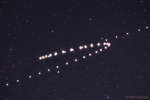 Retrograde Mars
Retrograde Mars
27.10.2014
Why would Mars appear to move backwards? Most of the time, the apparent motion of Mars in Earth's sky is in one direction, slow but steady in front of the far distant stars. About every two years, however, the Earth passes Mars as they orbit around the Sun.
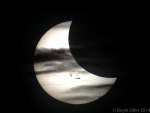 Plane, Clouds, Moon, Spots, Sun
Plane, Clouds, Moon, Spots, Sun
26.10.2014
What's that in front of the Sun? The closest object is an airplane, visible just below the Sun's center and caught purely by chance. Next out are numerous clouds in Earth's atmosphere, creating a series of darkened horizontal streaks.
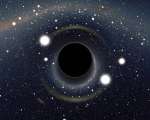 Too Close to a Black Hole
Too Close to a Black Hole
26.10.2014
What would you see if you went right up to a black hole? Featured is a computer generated image highlighting how strange things would look. The black hole has such strong gravity that light is noticeably bent towards it - causing some very unusual visual distortions.
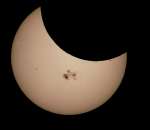 Sunspots and Solar Eclipse
Sunspots and Solar Eclipse
25.10.2014
A New Moon joined giant sunspot group AR 2192 to dim the bright solar disk during Thursday's much anticipated partial solar eclipse. Visible from much of North America, the Moon's broad silhouette is captured in this extreme telephoto snapshot near eclipse maximum from Santa Cruz, California.
 AR 2192: Giant on the Sun
AR 2192: Giant on the Sun
24.10.2014
As you (safely!) watched the progress of yesterday's partial solar eclipse, you probably also spotted a giant sunspot group. Captured in this sharp telescopic image from October 22nd the complex AR 2192 is beautiful to see, a sprawling solar active region comparable in size to the diameter of Jupiter.
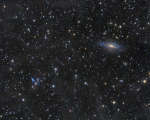 Galaxies in Pegasus
Galaxies in Pegasus
23.10.2014
This wide, sharp telescopic view reveals galaxies scattered beyond the stars and faint dust nebulae of the Milky Way at the northern boundary of the high-flying constellation Pegasus. Prominent at the upper right is NGC 7331.
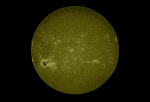 Sunspot Group AR 2192 Crackles
Sunspot Group AR 2192 Crackles
22.10.2014
One of the largest sunspot groups in recent years is now crossing the Sun. Labelled Active Region 2192, it has already thrown a powerful solar flare and has the potential to produce more.
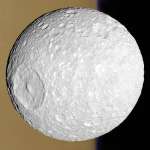 Mimas: Small Moon with a Big Crater
Mimas: Small Moon with a Big Crater
21.10.2014
Whatever hit Mimas nearly destroyed it. What remains is one of the largest impact craters on one of Saturn's smallest moons. The crater, named Herschel after the 1789 discoverer of Mimas, Sir William Herschel, spans about 130 kilometers and is pictured above.
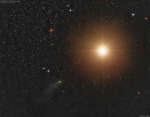 Comet Siding Spring Passes Mars
Comet Siding Spring Passes Mars
20.10.2014
Yesterday, a comet passed very close to Mars. In fact, Comet C/2013 A1 (Siding Spring) passed closer to the red planet than any comet has ever passed to Earth in recorded history. To take...
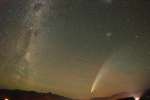 Comet McNaught Over New Zealand
Comet McNaught Over New Zealand
19.10.2014
Comet McNaught was perhaps the most photogenic comet of modern times -- from Earth. After making quite a show in the northern hemisphere in early January of 2007, the comet moved south and developed a long and unusual dust tail that dazzled southern hemisphere observers.
|
January February March April May June July August September October November December |
|||||||||||||||||||||||||||||||||||||||||||||||||